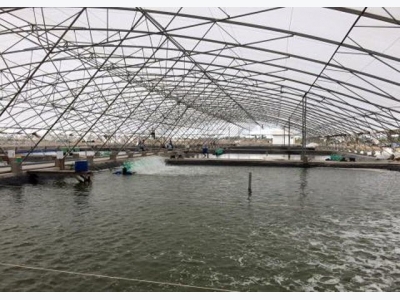Bạc Liêu targets becoming shrimp hub

One high-tech shrimp pond in Bạc Liêu Province. -- baodautu
Ho Chi Minh City – The Mekong Delta province of Bạc Liêu has begun plans to expand its shrimp aquaculture industry, beginning with the construction of the Bạc Liêu high-tech agricultural zone in Hiệp Thành Commune in Bạc Liêu City, which started earlier this year.
When completed by 2020, the 419-hectare zone worth VNĐ3.2 trillion (US$140 million) will be one of the largest in Southeast Asia and is expected to help Bạc Liêu become the national hub for the shrimp industry.
A local farmer, Đinh Vũ Hải from Vĩnh Trạch Đông commune in Bạc Liêu City, also began raising white-leg shrimp in a super-intensive aquaculture model in greenhouses.
Instead of depending on local authorities, Hải decided to come up with solutions to the massive losses of shrimp in the coastal region of the Mekong Delta caused by widespread disease.
In February 2017, Hải flew to Thailand and visited C.P. Group’s white-leg shrimp cultivation model in greenhouses.
After his return, he began raising shrimp at a capacity of 60 – 90 tonnes per hectare.
“This model allows shrimp to grow big, and the capacity can reach 200 tonnes per ha each year,” he said.
After Hải, many big companies, including the Việt Nam – Australia Group, invested VNĐ1 trillion ($44 million) to build a closed production chain that includes a shrimp feed and food processing factory, and the management of processed shrimp for export. The production is located on 500 hectares in Hiệp Thành Commune.
Global ambitions
These models are expected to change the traditional shrimp industry by increasing capacity by 10 to 15 times.
Thanks to progress in high-tech shrimp cultivation, central and local authorities hope the province will become the national shrimp hub and contribute to making Việt Nam one of the biggest global shrimp exporters.
To obtain the goal, the province has received approval from the Government to shift the planned construction of thermal power plants to wind and solar power plants, aiming to maintain a clean environment for the high-tech shrimp industry.
Wind and solar power projects and high-tech shrimp aquaculture are attracting interest from investors, with substantially more capital than last year.
Construction on two wind power plants with capacity of 172 MW began on January 30.
In addition, 20 companies applied to operate inside the recently built Bạc Liêu high-tech agricultural zone. However, only seven of them were accepted.
After Bạc Liêu high-tech agricultural zone opens, there will be 100 units for super-intensive shrimp aquaculture in households in the high-tech agricultural zone.
Microchips will be used in every shrimp pond to maintain 16 standards related to the environment and shrimp health.
For example, if the shrimp need to be fed, the chip will send ultrasound waves to machines that will drop food into the pond.
The technology used for the shrimp model saves food costs and reduces pollution.
“Technology plays a very important part in increasing the value chain for the shrimp industry,” Lương Thanh Văn, chairman and CEO of the Việt Nam–Australia Group, said.
“Bạc Liêu Province is still one of the poorest ones in the Mekong Delta. The province aims to improve the situation within the next 15 years by creating shortcuts,” Dương Thành Trung, chairman of the provincial People’s Committee, said.
“High-tech shrimp cultivation is one of the key industries that can help the province obtain its goal, and authorities should create a better business environment for domestic and foreign investors,” he added.
INBOX:
High-tech shrimp models in Bạc Liêu Province have been economically effective. For instance, Long Mạnh Limited has four ponds on some 2,000 sq.m with a total capacity of five tonnes per pond.
Trúc Anh Trade & Production Limited is using a two-stage shrimp feeding model. In the first stage, baby shrimp are fed in a house for 20 – 30 days to avoid external factors.
After that, shrimp are moved to a nearby pond for 70 – 80 days. Instead of using chemical substances as they did traditionally, farmers use bio-products and only need to replenish the water and not change it several times as they did in the past because of pollution concerns.
The company has three harvests of shrimp at about 150 tonnes per hectare.
The model is considered to be viable for both household and big farm production.
Có thể bạn quan tâm
 Đồng Tháp farmers bet on tra fish
Đồng Tháp farmers bet on tra fish Đồng Tháp Province, already the largest tra fish producer in the Cửu Long (Mekong) Delta, has further increased the breeding area this year because of the high
 High-tech shrimp breeding brings higher profits to farmers
High-tech shrimp breeding brings higher profits to farmers More than two years ago, Dang Thanh Tan, a farmer in Binh Minh town, northern Ninh Binh province, decided to switch from breeding shrimp in traditional ponds
 China overtakes the US as the largest import market for catfish from Vietnam
China overtakes the US as the largest import market for catfish from Vietnam The total export value in 3 months of 2018 reached more than $US 719 million, an increase of 16% over the same period